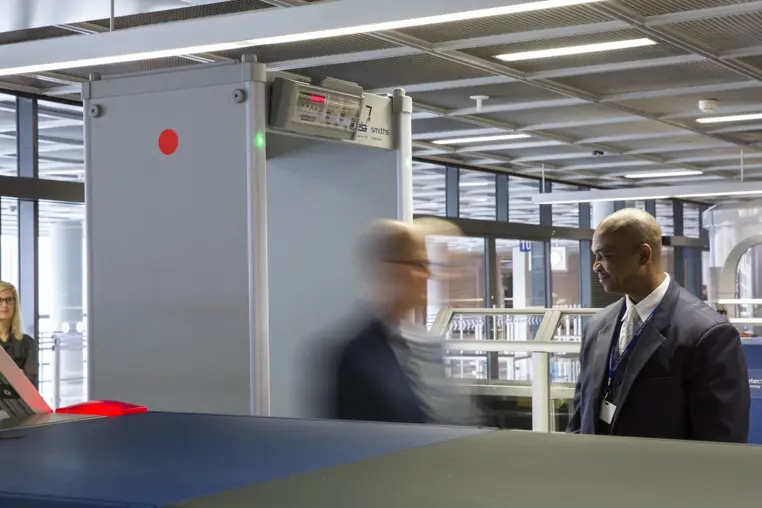Complete, networked solutions that allow for random, portable employee screening options can help to deter threats while still supporting an airport’s operational efficiency.
Despite the fact that airport employees must pass background checks, the last several years have seen many shocking – and sometimes deadly – examples of employees misusing their access to secure areas of an airport to smuggle drugs, weapons or explosive devices. In 2014, federal authorities disrupted a gun-smuggling ring operating in Atlanta’s Hartsfield-Jackson airport. In 2015, an employee at Egypt’s Sharm el-Sheikh airport was suspected of placing a homemade explosive device on Metrojet flight 9268, which exploded midflight and killed all 224 people on board. In 2016, a flight attendant at LAX was discovered trying to smuggle more than 70 pounds of drugs in her bags. According to the Wall Street Journal, approximately 950,000 employees across more than 450 U.S. airports can use their credentials to access secure areas of an airport with little to no additional screening. This series explores how airports can better protect travelers, staff and facilities from the Insider Threat.
Enhancing Security While Maintaining Efficiency
Concern about instituting employee screening to address the insider threat has centered often on the impact it would have on employee efficiency and airport operations. The proper combination of technologies can support the use of random employee screenings, which can help improve risk deterrence while still helping employees work as quickly as efficiently as necessary.
Unlike travelers, most employees don’t carry around packages so employee screening won’t have the same impact on operations as passenger screening does on travel. However, for those that are carrying items, threat detection solutions, such as x-rays, offer a quick look inside to detect threats and flag secondary screening needs or let regular employees get moving.
AT x-ray systems use advanced imaging technology to highlight suspect objects during inspections in real-time. The use of x-rays, with multiple views and automatic explosive detection further supports a quick and reliable evaluation process and reduces instances of unnecessary secondary screening of employees.
Trace detection of explosives or narcotics is also a critical layer to comprehensive employee screenings practices. The best trace detection methods operate at speeds similar to the amount of time it takes to inspect an object with x-ray. This duration ensures efficient movement of workers around an airport. Or, in other instances, random trace screening methods are deployed, so not every employee is subject to the process.
Portable Technology Enables Greater Deterrence
A common question about instituting employee screening at airports is how to establish it at all secure access points. To do so, would inevitable drive the costs out of reach and cause employees to simply circumvent those access points. Therefore, a key to successful deterrence is random, portable screening solutions that can move screening capabilities around an airport. TSA’s Aviation Security Advisory Committee said in its 2015 report on addressing the insider threat: “TSA, with associated industry support, should increase the frequency of random and unpredictable employee screening/inspection at airports.”
Some technologies are inherently portable because they are compact, lightweight and durable.
Alternative methods for deploying random checkpoints included Mobile Security Checkpoints that are trailer pulled up to a site. Typically, these solution utilizes a standardized 20 ft. container which houses a complete x-ray system, trace explosives systems and other CRNE identification devices. A successful deployment would need to be setup or dismantled in less than 30 minutes, however enables an adaptable layout to meet individual airport needs and environmental requirements. Perhaps, even more mobile are vehicle based checkpoints, such as ScanVans, which drive directly to various sites in an instance. These solutions contain a build in, portable X-ray systems, foldable conveyors for easy bag and package handling and are weatherized. Like the Mobile Security Checkpoint, the van platform is ideal for outdoor screening operations and include a climate controlled cabin and operator station.
These two mobile platforms demonstrate how employee screening can address the problems of cost and deterrence associated with permanent employee screening sites, while still offering protection against the insider threat.
Managing Budget Requirements by Considering The Whole Cost
Airports need to make the investment in technologies as identified in this series to ensure proactive employee screening measures deter criminal or terrorist activity on airport grounds. The key to successful technology procurement is to identify solutions that are built to be cost-effective and are capable of the rigors operations as neede. That means identifying customized, future-proof solutions that are part of a long-term security strategy which meets the needs of today and tomorrow.

